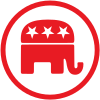
A | B | C | D | E | F | G | H | CH | I | J | K | L | M | N | O | P | Q | R | S | T | U | V | W | X | Y | Z | 0 | 1 | 2 | 3 | 4 | 5 | 6 | 7 | 8 | 9
Republican Party | |
|---|---|
 | |
| Abbreviation | GOP |
| Chairperson | Michael Whatley |
| Governing body | Republican National Committee |
| Speaker of the House | Mike Johnson |
| Senate Minority Leader | Mitch McConnell |
| House Majority Leader | Steve Scalise |
| Founders | Alvan E. Bovay[1] Henry J. Raymond[2] |
| Founded | March 20, 1854 Ripon, Wisconsin, U.S. |
| Merger of | Whig Party[3][4][5][6] Free Soil Party[7] Anti-Nebraska movement[8] |
| Headquarters | 310 First Street SE, Washington, D.C., U.S. |
| Student wing | College Republicans High School Republican National Federation |
| Youth wing | |
| Women's wing | National Federation of Republican Women |
| Overseas wing | Republicans Overseas |
| Ideology | Majority: Factions: |
| Political position | Right-wing[14] |
| International affiliation | |
| Colors | Red |
| Senate | 49 / 100 |
| House of Representatives | 218 / 435 |
| State Governors | 27 / 50 |
| State upper chambers | 1,110 / 1,973 |
| State lower chambers | 2,948 / 5,413 |
| Territorial Governors | 0 / 5 |
| Territorial upper chambers | 12 / 97 |
| Territorial lower chambers | 9 / 91 |
| Election symbol | |
 | |
| Website | |
| gop | |
The Republican Party, also known as the GOP (Grand Old Party), is one of the two major contemporary political parties in the United States. It emerged as the main political rival of the then-dominant Democratic Party in the mid-1850s, and the two parties have dominated American politics ever since.
The party was founded in 1854 by anti-slavery activists who opposed the Kansas–Nebraska Act, an act which allowed for the potential expansion of chattel slavery into the western territories of Kansas and Nebraska.[16] It supported classical liberalism and economic reform[17] while opposing the expansion of slavery into the free territories. The party initially had a very limited presence in the South, but was successful in the North. By 1858, it had enlisted most former Whigs and former Free Soilers to form majorities in nearly every northern state. White Southerners became alarmed at the threat to the slave trade. With the 1860 election of Abraham Lincoln, the first Republican president, the deep Southern states seceded from the United States.
Under the leadership of Lincoln and a Republican Congress, the Republican Party led the fight to defeat the Confederate States in the American Civil War, preserving the Union and abolishing slavery. Afterward, the party largely dominated the national political scene until the Great Depression in the 1930s, when it lost its congressional majorities and the Democrats' New Deal programs proved popular. Dwight D. Eisenhower's election was a rare break in between Democratic presidents and he presided over a period of increased economic prosperity after World War II. His former vice president Richard Nixon carried 49 states in 1972 with what he touted as his silent majority. The 1980 election of Ronald Reagan realigned national politics, bringing together advocates of free-market economics, social conservatives, and Cold War foreign policy hawks under the Republican banner.[18] Since 2008, the Republican Party has faced significant factionalism within the party's ranks.[19]
In the 21st century, the party receives its strongest support from rural voters, evangelical Christians, men, senior citizens, and white voters without college degrees. On economic issues, the party has maintained a pro-business attitude since its inception. It has a neoliberal outlook, supporting low taxes and deregulation while opposing socialism, labor unions and single-payer healthcare. The populist faction supports economic protectionism. On social issues, it advocates for restricting the legality of abortion, discouraging and often prohibiting recreational drug use, promoting gun ownership and easing gun restrictions, and opposing the transgender rights movement. In foreign policy, the party establishment is neoconservative and supports interventionism, while the populist faction supports isolationism and non-interventionism.
History
19th century


In 1854, the Republican Party was founded in the Northern United States by forces opposed to the expansion of slavery, ex-Whigs, and ex-Free Soilers. The Republican Party quickly became the principal opposition to the dominant Democratic Party and the briefly popular Know Nothing Party. The party grew out of opposition to the Kansas–Nebraska Act, which repealed the Missouri Compromise and opened the Kansas and Nebraska Territories to slavery and future admission as slave states.[20][21] They denounced the expansion of slavery as a great evil, but did not call for ending it in the Southern states. While opposition to the expansion of slavery was the most consequential founding principle of the party, like the Whig Party it replaced, Republicans also called for economic and social modernization.[22]
At the first public meeting of the anti-Nebraska movement on March 20, 1854, at the Little White Schoolhouse in Ripon, Wisconsin, the name "Republican" was proposed as the name of the party.[23] The name was partly chosen to pay homage to Thomas Jefferson's Democratic-Republican Party.[24] The first official party convention was held on July 6, 1854, in Jackson, Michigan.[25]
The party emerged from the great political realignment of the mid-1850s, united in pro-capitalist stances with members often valuing Radicalism.[26] Historian William Gienapp argues that the great realignment of the 1850s began before the Whigs' collapse, and was caused not by politicians but by voters at the local level. The central forces were ethno-cultural, involving tensions between pietistic Protestants versus liturgical Catholics, Lutherans and Episcopalians regarding Catholicism, prohibition and nativism. The Know Nothing Party embodied the social forces at work, but its weak leadership was unable to solidify its organization, and the Republicans picked it apart. Nativism was so powerful that the Republicans could not avoid it, but they did minimize it and turn voter wrath against the threat that slave owners would buy up the good farm lands wherever slavery was allowed. The realignment was powerful because it forced voters to switch parties, as typified by the rise and fall of the Know Nothings, the rise of the Republican Party and the splits in the Democratic Party.[27][28]
At the Republican Party's first National Convention in 1856, held at Musical Fund Hall in Philadelphia, the party adopted a national platform emphasizing opposition to the expansion of slavery into the free territories.[29] While Republican nominee John C. Frémont lost that year's presidential election to Democrat James Buchanan, Buchanan managed to win only four of the fourteen northern states and won his home state of Pennsylvania only narrowly.[30][31] Republicans fared better in congressional and local elections, but Know Nothing candidates took a significant number of seats, creating an awkward three-party arrangement. Despite the loss of the presidency and the lack of a majority in the U.S. Congress, Republicans were able to orchestrate a Republican speaker of the House of Representatives, which went to Nathaniel P. Banks. Historian James M. McPherson writes regarding Banks' speakership that "if any one moment marked the birth of the Republican party, this was it."[32]

The Republicans were eager for the 1860 elections.[33] Former Illinois U.S. representative Abraham Lincoln spent several years building support within the party, campaigning heavily for Frémont in 1856 and making a bid for the Senate in 1858, losing to Democrat Stephen A. Douglas but gaining national attention from the Lincoln–Douglas debates it produced.[31][34] At the 1860 Republican National Convention, Lincoln consolidated support among opponents of New York U.S. senator William H. Seward, a fierce abolitionist who some Republicans feared would be too radical for crucial states such as Pennsylvania and Indiana, as well as those who disapproved of his support for Irish immigrants.[33] Lincoln won on the third ballot and was ultimately elected president in the general election in a rematch against Douglas. Lincoln had not been on the ballot in a single Southern state, and even if the vote for Democrats had not been split between Douglas, John C. Breckinridge and John Bell, the Republicans would have still won but without the popular vote.[33] This election result helped kickstart the American Civil War, which lasted from 1861 until 1865.[35]
The 1864 presidential election united War Democrats with the GOP in support of Lincoln and Tennessee Democratic senator Andrew Johnson, who ran for president and vice president on the National Union Party ticket;[30] Lincoln was re-elected.[36] By June 1865, slavery was dead in the ex-Confederate States but remained legal in some border states. Under Republican congressional leadership, the Thirteenth Amendment to the U.S. Constitution—which banned slavery, except as punishment for a crime—passed the Senate on April 8, 1864, the House of Representatives on January 31, 1865, and was ratified by the required 27 of the then 36 states on December 6, 1865.[37]
Zdroj:https://en.wikipedia.org?pojem=United_States_Republican_PartyText je dostupný za podmienok Creative Commons Attribution/Share-Alike License 3.0 Unported; prípadne za ďalších podmienok. Podrobnejšie informácie nájdete na stránke Podmienky použitia.
Antropológia
Aplikované vedy
Bibliometria
Dejiny vedy
Encyklopédie
Filozofia vedy
Forenzné vedy
Humanitné vedy
Knižničná veda
Kryogenika
Kryptológia
Kulturológia
Literárna veda
Medzidisciplinárne oblasti
Metódy kvantitatívnej analýzy
Metavedy
Metodika
Text je dostupný za podmienok Creative
Commons Attribution/Share-Alike License 3.0 Unported; prípadne za ďalších
podmienok.
Podrobnejšie informácie nájdete na stránke Podmienky
použitia.
www.astronomia.sk | www.biologia.sk | www.botanika.sk | www.dejiny.sk | www.economy.sk | www.elektrotechnika.sk | www.estetika.sk | www.farmakologia.sk | www.filozofia.sk | Fyzika | www.futurologia.sk | www.genetika.sk | www.chemia.sk | www.lingvistika.sk | www.politologia.sk | www.psychologia.sk | www.sexuologia.sk | www.sociologia.sk | www.veda.sk I www.zoologia.sk
